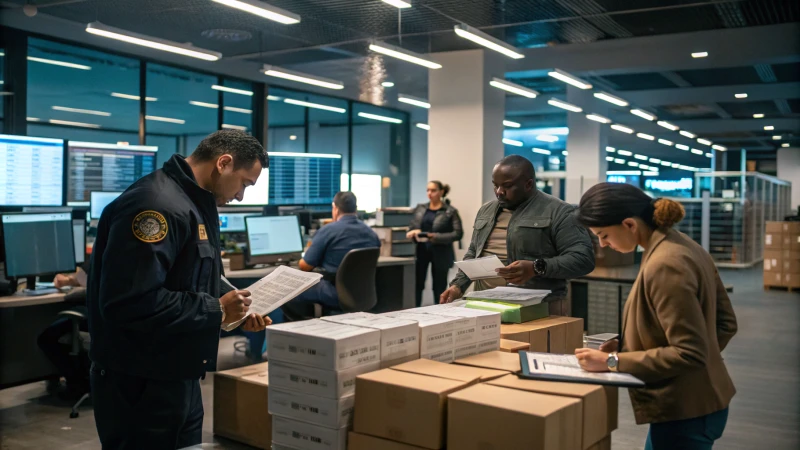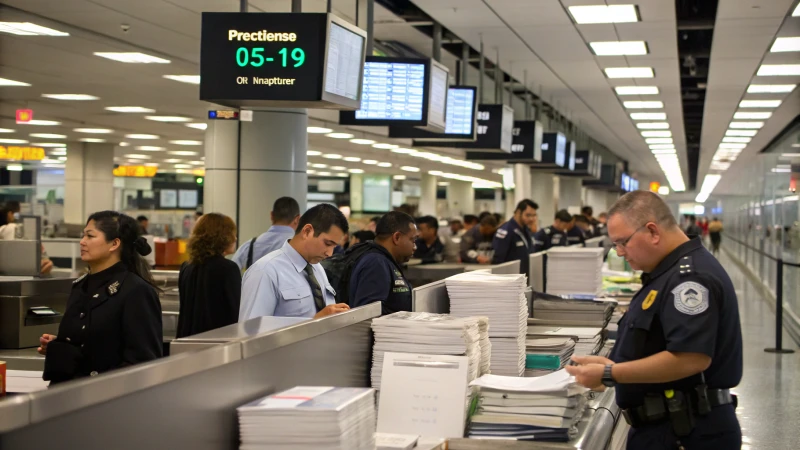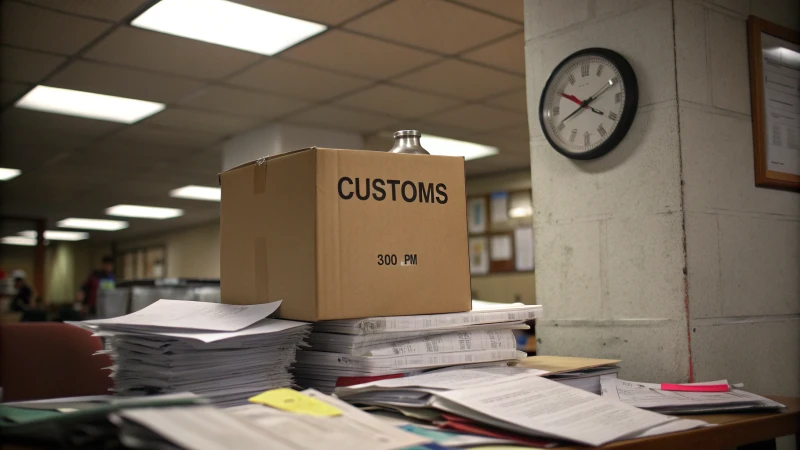Ah, the suspense of waiting for an international package! We've all been there, right?
Packages can typically linger in customs for anywhere from 3 to 15 days. However, if there are issues like missing documentation or the need for a detailed inspection, you might be looking at a delay of 2 to 4 weeks, or sometimes even longer.
I remember anxiously tracking a shipment of gadgets from China once, and the wait felt endless. It got me wondering about what actually goes on behind the scenes when a package hits customs. Understanding these factors not only eased my nerves but also helped me plan better for future shipments. Let's explore what might cause these delays and how you can potentially speed things up.
Packages stay in customs up to 4 weeks.True
Packages can be held due to documentation issues or inspections.
All packages clear customs within 3 days.False
Delays can extend up to 4 weeks due to various factors.
What Are the Common Causes of Customs Delays?
Ever found yourself tangled in the web of customs delays? It's like waiting for a kettle to boil, only it feels like it's taking forever! Let's unravel this mystery together.
Common causes of customs delays often stem from incorrect documentation, regulatory non-compliance, insufficient duty payments, and intensified security checks. By addressing these issues head-on, you can help ensure smoother customs processing.

Incorrect Documentation
Imagine you're eagerly waiting for a shipment of the latest consumer electronics, only to find out it's stuck at customs due to paperwork errors. Talk about a buzzkill! I've learned that even a minor mistake, like an incorrect HS code1, can throw a wrench in the works. This reminds me of the time I had a shipment delayed because the bill of lading had the wrong address. Oh, the lessons learned the hard way!
| Common Documents | Purpose |
|---|---|
| Bill of Lading | Details cargo ownership and route |
| Commercial Invoice | Declares value and nature of goods |
| Packing List | Lists items included in shipment |
Regulatory Non-Compliance
Navigating import regulations feels like solving a complex puzzle without all the pieces. Each country has its unique rules, and slipping up on even one can lead to significant delays. I remember a shipment of electronics that needed specific safety certifications—without them, customs was a no-go zone. It was a stark reminder to double-check every requirement.
For instance, electronic devices may require specific certifications to confirm they meet safety standards. Failure to provide these can result in lengthy inspections.
Insufficient Duty Payments
There's nothing worse than having your goods held hostage because of a payment hiccup. Trust me, I've been there! A simple miscalculation in duties can halt everything. That's why having a customs broker2 on your side is invaluable—they're like the financial navigators of the shipping world.
Underpayment or non-payment of duties and taxes can halt a shipment at customs. It's critical to correctly calculate these fees before goods reach customs.
Heightened Security Checks
In today's world, increased security measures are the norm. Random inspections or heightened security alerts can add unexpected delays. Once, I had a shipment delayed simply because there was a security alert that week.
Ensuring all my ducks are in a row with documentation and working with reputable supply chain partners3 has helped me minimize these setbacks.
Understanding these challenges empowers me—and businesses like mine—to anticipate delays and develop strategies to keep things moving as smoothly as possible. It's all part of the journey in international trade.
Incorrect documentation causes customs delays.True
Errors or omissions in required documents often lead to shipment hold-ups.
Security checks have no impact on customs delays.False
Heightened security measures can lead to random or targeted inspections.
How Can Documentation Affect Customs Processing Times?
Navigating the maze of customs can be daunting, but nailing your documentation can make all the difference in shipping success.
Documentation is crucial in determining customs processing times. Correct and complete paperwork ensures fast clearance, minimizing delays. Mistakes or missing documents can result in longer processing and inspections, affecting shipping timelines and costs.
The Importance of Accurate Documentation
I remember the first time I faced a customs delay. I was anxiously waiting for a shipment of electronics that was stuck at customs due to a missing invoice detail. It felt like time stood still as I imagined disappointed clients waiting on me. This experience taught me that documentation is like the passport for goods in international shipping. When details are incomplete or wrong, customs may put shipments on hold for verification, delaying delivery and potentially adding extra costs.
A key element of the customs declaration4 is the commercial invoice, which details product description, value, and origin. Errors here can set off alarm bells for customs officials.
Common Documentation Mistakes and Their Impact
Once, during an especially busy season, I mistakenly listed the wrong tariff codes on a shipment. It led to misclassification and resulted in incorrect duties being charged. Customs decided to take a closer look at my shipment, causing further delays. This incident reinforced how crucial it is to avoid errors like incorrect tariff codes or product descriptions, which can lead to detailed inspections.
If you're like me, importing consumer electronics from China, a simple oversight in documenting electronic components could mean days added to your customs clearance timeline.
How to Ensure Proper Documentation
To keep things running smoothly, I created a checklist for my shipments. It includes all necessary documents tailored to the destination and type of goods:
| Document Type | Description |
|---|---|
| Commercial Invoice | Details of goods |
| Packing List | Shipping specifics |
| Certificate of Origin | Product origin |
I also found that working with freight forwarding services like Gofreighter5 has been a game-changer in ensuring all my documents are in order and accurate.
The Role of Technology in Documentation
Technology has become my best friend when it comes to managing documentation. Digital document management systems have helped me track and verify documents before they head off to customs. These systems minimize human error and improve communication between shippers and customs officials.
By adopting tools that automate the documentation process, I've significantly reduced errors and ensured quicker customs processing6. This approach is vital for anyone in time-sensitive industries where delays can lead to substantial financial losses.
Incomplete documentation delays customs processing.True
Incomplete or inaccurate documents require verification, delaying shipments.
Using digital tools can reduce customs delays.True
Digital document systems minimize human error, speeding up customs processes.
How Can I Speed Up Customs Clearance?
Stuck in customs is no one's idea of fun. If you’re anything like me, a smooth and quick clearance is gold.
To expedite customs clearance, focus on accurate documentation, use pre-arrival processing, and consider trusted trader programs like AEO or C-TPAT. These strategies can significantly reduce delays.

The Importance of Accurate Documentation
I remember the first time I faced a delay at customs due to missing paperwork. It felt like watching a pot that never boils. Getting your documents right is crucial. You need to have everything from invoices to packing lists, and don't forget the certificates of origin. Trust me, having all your ducks in a row can save you from unnecessary headaches.
| Document Type | Purpose |
|---|---|
| Invoice | Details goods and transaction |
| Packing List | Describes contents of the shipment |
| Certificate of Origin | Verifies where goods were produced |
Leveraging Pre-Arrival Processing
Have you ever tried pre-arrival processing? It's like having a head start in a marathon. Customs officers can begin their assessment before your shipment even hits the border. This proactive step can clear up potential issues before they become real problems. And with most countries offering electronic submissions, it’s easier than ever to get ahead.
Trusted Trader Programs
Joining trusted trader programs has been a game changer for me. Programs like AEO7 (Authorized Economic Operator) and C-TPAT8 (Customs-Trade Partnership Against Terrorism) help my business breeze through customs with reduced inspections and priority processing. Yes, there are security standards to meet, but the efficiency gains are worth it.
Streamlining Through Technology
Technology has been my best friend in expediting customs processes. Implementing Electronic Data Interchange (EDI) systems has made data transfer between shippers, carriers, and customs authorities swift and seamless. Plus, mobile apps let me track shipments and manage logistics from anywhere.
For frequent shipments, investing in logistics software9 has automated many processes for me, reducing human error and speeding things up. These tools integrate seamlessly with existing systems to provide real-time updates and analytics, making the whole process feel like less of a juggling act.
In essence, the key to speeding up customs clearance lies in meticulous preparation and leveraging the right resources. It's about turning potential hurdles into stepping stones towards a smoother operation.
Accurate documentation speeds up customs clearance.True
Accurate documents prevent delays by ensuring smooth processing.
Trusted trader programs increase shipment inspections.False
These programs reduce inspections by meeting security standards.
What Should You Do If Your Package Is Stuck in Customs?
We've all been there—waiting eagerly for that one package, only to find out it's stuck at customs. It's frustrating, right? But don't worry, I'm here to walk you through it.
If your package is stuck in customs, first ensure all your documentation is complete and correct. Get in touch with your carrier for updates, and consider hiring a customs broker if things get complicated.

Understanding Why Packages Get Stuck
I remember the first time one of my shipments got held up at customs. It was like waiting for a pot to boil—endless. Packages often get stuck due to missing paperwork, unpaid fees, or the need for extra inspections. Understanding these reasons can make all the difference.
Verifying Documentation
Once, I found myself frantically searching through my files, realizing I’d missed a crucial document. It’s vital to ensure everything is accurate: invoices, shipping labels, and any specific forms required by the destination country. Double-checking this documentation10 can often solve the problem.
Communication with Your Carrier
I can’t stress enough how important it is to keep the lines of communication open with your carrier. I’ve learned that they can provide insights and guidance on next steps if you reach out.
| Carrier Contact Details |
|-------------------------|
| UPS: 1-800-742-5877 |Hiring a Customs Broker
When things get complex, bringing in a customs broker can feel like having a seasoned guide by your side. They’ll communicate with officials and make sure all requirements are met, helping speed up the process.
Calculating Potential Costs
I’ve had my fair share of surprises with unexpected fees—import duties or storage charges if the package lingers too long. Using a duty calculator11 can help anticipate these costs.
Proactive Steps for Future Shipments
Over time, I’ve learned to take proactive steps like using pre-clearance12 processes or partnering with a reliable shipper familiar with my destination's regulations. These strategies have significantly reduced delays.
Collaborating with Your Suppliers
Maintaining a strong relationship with your suppliers is key. I always ensure they know the importance of providing accurate documentation and labeling from the start. This teamwork helps prevent customs issues and streamlines the supply chain.
By understanding these steps, you can navigate customs like a pro, minimizing delays and keeping your shipments on track. Explore these options to find what works best for you, ensuring smooth sailing in your import/export endeavors.
Incomplete documentation can delay customs clearance.True
Missing or incorrect paperwork often leads to customs delays.
Contacting your carrier won't help resolve customs issues.False
Carriers can provide insights and guidance on customs delays.
Conclusion
Packages can be stuck in customs for 3 to 15 days, but delays due to documentation issues or inspections may extend this period to 2-4 weeks or longer.
-
Understanding HS codes is crucial for accurate customs declarations and avoiding delays. ↩
-
A customs broker can help streamline complex customs processes, ensuring compliance and minimizing delays. ↩
-
Reliable partners reduce risks of delays due to security checks and ensure smooth logistics operations. ↩
-
Understanding the role of a commercial invoice is vital for accurate customs processing, reducing delays and avoiding costly errors. ↩
-
Freight forwarding services offer expertise and support in managing documentation, ensuring compliance with international trade regulations. ↩
-
Technology solutions streamline documentation processes, reducing errors and enhancing communication with customs officials for faster clearance. ↩
-
Learn about the Authorized Economic Operator program and how it streamlines customs processes for certified companies. ↩
-
Discover how C-TPAT membership offers benefits like reduced inspections and faster processing through customs. ↩
-
Explore top logistics software that can automate and enhance your customs clearance processes. ↩
-
Learn what documents are typically required for customs clearance to ensure you're fully prepared. ↩
-
Understand how to calculate import duties to avoid unexpected costs and plan your budget accurately. ↩
-
Discover how pre-clearance processes can expedite your international shipping and minimize delays. ↩




